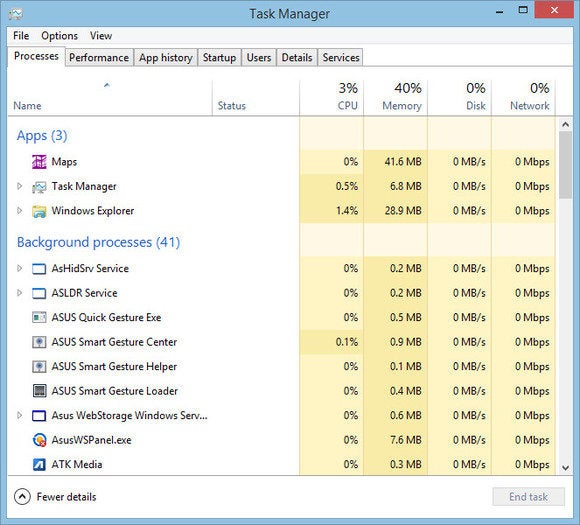How To Stop Background Process In Windows 8
Bobby Ekwere asked "Is in that location any free software that allows me to see and disable unwanted programs running in the background?"
Probably, but I know something amend than free software for this task: software that comes with Windows. All current versions of Windows come with a tool to help yous trim back what'southward running at the moment.
The look, behavior, and feel of this tool changed drastically (and for the better) with Windows 8. I'll cover Windows vii and Windows 8 here, only the Windows 7 directions should work reasonably well with XP and Vista.
[Have a tech question? Inquire PCWorld Contributing Editor Lincoln Spector. Send your query to respond@pcworld.com .]
The tool is called Task Manager. To open it, right-click the taskbar and selecting Chore Manager or Start >Task Manager,depending on your version of Windows.

In the Windows seven version, the Applications tab displays currently-running applications.
But what's the difference between an application and a program?
In this context, an application is a program with its own window–either visible on the desktop or minimized to the taskbar. For case, your browser, if it's running, is an awarding and is listed here. Your antivirus program won't show up in this list until you double-click the tiny icon in the notification area and bring upwardly the window.
All applications tin can be closed from inside the application–you merely click the 10 in the upper-correct corner. Merely if that doesn't work, yous can use the End Task push button on Job Manager'due south Applications tab.
Only if Windows is overloaded, the trouble is probably not applications, but processes–threads of lawmaking running in the groundwork. So click the Processes tab. Every bit I write this, the Job Manager tells me that I'm running three applications, simply 134 processes–16 simply for Chrome.

The Processes tab is laid out as a tabular array, and like virtually Windows tables, you tin can sort it by clicking the column headings. Click Epitome Name, and yous alphabetize the processes. Click CPU, and y'all can encounter which processes are hogging the processor (most aren't). Click Memory, and you lot'll see which ones are hogging RAM.
To stop a process, click the End Process button, and ostend that that's what you really want to practice.
The Windows 8 version behaves much the aforementioned way. The window is better designed and easier to read, and there are a few important differences.
Starting time of all, in that location's no Applications tab. Just you'll see both applications and Metro/Modernistic Interface apps listed at the superlative of the Processes tab.

This layout allows you to see programs and processes together. Windows places icons next to the processes to help yous figure out what program launched them.

Simply you might detect that the Processes tab lacks a Description column–a seemingly serious deficiency if you're trying to effigy out what a process does. But there'southward a solution. Right-click the process you lot're wondering nearly and select Go to details.
This will take yous to the Details tab, where the Description column now lives. It will besides take you to the same procedure, so you don't have to look for it again.
How To Stop Background Process In Windows 8,
Source: https://www.pcworld.com/article/440367/how-to-kill-unwanted-processes-and-applications-that-slow-down-windows.html
Posted by: scottworsoll.blogspot.com


0 Response to "How To Stop Background Process In Windows 8"
Post a Comment